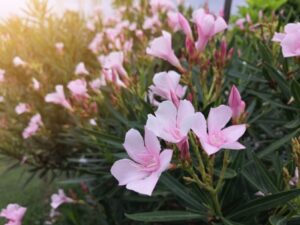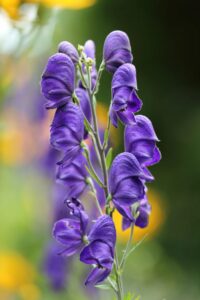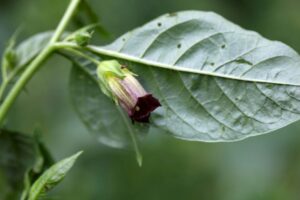
Did you know that a lot of garden plants are toxic to dogs and cats? Before you head to the garden centre to pick out your perfect Pinterest-worthy plants, it’s worth knowing which ones might pose a hazard to your pet. Here’s our ultimate guide to plant shopping for pet parents.
At Burns, we’ve been hearing a lot about the increase in people getting pets during the last year, but did you know there has also been a massive boom in people buying houseplants too? We’ve all been spending more time inside and houseplants are an amazing way to bring a little bit of the outdoors in. They’ve also been found to have mood boosting benefits. Not to mention, if you can keep one alive for long enough, they can make your home look amazing! It’s clear that houseplants have great benefits, but how do you know which plants are pet safe?
Nutrition manager, Laura and her dog, Amber have an extensive collection of houseplants, but luckily Amber hasn’t taken much of an interest in the houseplants. Some pets, however, are a little more curious, and if you have a particularly toxic houseplant, their curiosity can spell disaster. Fortunately, many websites have ‘pet friendly houseplants’ sections, but if in doubt, your local plant shop or garden centre should also be able to advise you.
Here are some of Laura’s favourites:

Top (left to right)- Ponytail Palm, String of Hearts, Terrarium, Bottom- Calathea Whitestar, Fishbone Cactus, Amber the Staffy, Calathea Whitestar
It’s great to know which plants can bloom in harmony with our doggos and kittys, but which plants pose a health hazard? Here’s Laura’s list of plants that are toxic to our pets:
We’ve talked about keeping your pet safe from your houseplants, but we also need to keep our plants safe from our pets! Some pets will try to chew the plant or knock it over, so here are Laura’s top tips for keeping cats and dogs away from your plants.
If you have a dog, keeping a plant on a shelf that is out of reach is an easy way to make sure they are both living happily together. This isn’t quite as easy when you have cats, but a wall or ceiling-mounted plant hanger may be useful in this case.
These are a great way to keep your plants away from you pets as they will be in a glass enclosure. Terrariums are complete, enclosed small plant ecosystems that can actually make the plant growing experience easier! They look lovely too!
Amber spends most of the day wanting to sit on a window ledge to see out of the window, so I avoid putting plants in these areas, so she doesn’t knock them off when she tries to chase off a cat! However, if your pet doesn’t spend a lot of time on the window ledges in your home, this could be a good option.
Heavier planters can help to prevent them being easily knocked over, especially if you have an excited Staffy doing ‘zoomies’ which often happens in our house!
Regularly pruning plants is a great way to keep them out of the way of your pets. This may be particularly important with hanging plants as they start to grow within their reach.
Your garden is another place your pet might love to explore, but it too might contain plants that are toxic to our dogs or cats. Even if your pet doesn’t appear to be interested in the plants in your garden, we should be aware of any potential hazards. Burns nutritional advisor and gardening enthusiast, Karen, guides us through her pet-friendly garden.

Photo: Oleander or Dogbane
It is surprising how many common garden plants can be harmful for dogs and cats. Most of them would need to be eaten in large quantities, so are unlikely to be problematic, others may just result in mild symptoms or an upset tummy for a day or two. Some are more of an irritant causing rashes or swelling.
Some of the most popular garden plants can be fatal, so it’s important to know which plants to stay away from if you have pets.
These plants can cause swelling in the mouth which can be life threatening to pets if the airway becomes blocked.
More commonly known as Monkshood, this plant is probably one of the most dangerous (and attractive) plant in our gardens. All parts are poisonous, the root was used historically to kill wolves, hence the name.
All parts of a rhododendron bush, including the leaves, are toxic to both cats and dogs. Only a small amount is needed to cause huge upset in our dogs and cats, such as nausea, vomiting and even difficulty breathing.
Azaleas are beautiful plants that feature in many of our homes and gardens, but they are considered poisonous to our dogs and cats.
A unique plant responsible for producing ‘caster oil.’ Unfortunately, its highly toxic for dogs, cats and even horses. The beans and seeds are particularly dangerous, and can be lethal if even an ounce is consumed.
Commonly used in landscaping, these beautiful plants are toxic for all mammals. Ingestion of any part of this plant can lead to terrifying consequences for our pets.
This common evergreen plant is extremely poisonous to all species. Ingesting any part of the English yew plant can cause symptoms such as nausea, vomiting and diarrhoea, and can even lead to death.
Commonly known as larkspur, this beautiful, tall, flowering plant can be fatal if ingested in large amounts. However, for smaller, and younger pets, it can also prove fatal if only a small amount is ingested.

Photo: Wolfsbane
Some wild plants can also prove fatal for our pets. Wild plants such as well as Deadly Nightshade and Ragwort, for example, can cause irreversible kidney and liver damage when ingested.

Photo: Nightshade
There are no typical symptoms, so it’s important to stay vigilant if you suspect your pet has eaten something they shouldn’t. Symptoms can include:
If you suspect your pet has eaten something and is showing unusual signs or behaviour seek veterinary help ASAP, taking the suspect plant with you if possible.
Not all parts of the plants may be toxic. It might only be the fruit, roots, bark or even the stem, but it is best to assume the whole plant is poisonous. Even our vegetable plots may contain plants with parts that are harmful. Apricot kernels contain cyanide, Rhubarb leaves contain oxalic acid and can be fatal if eaten in quantity.
Burns’s Top Tip: Pay attention to plant names. Often the name of the plant gives us a clue, for example, Deadly Nightshade, Wolfsbane and Dogbane, are all part of the Latin name ‘Apocynum’ means ‘away dog’.
There are plenty of plants that are safe to have in your garden and home and they can even provide enrichment for your pets, but it’s always advisable to do your research before you shop.
Remember, if you feel as though your dog or cat has eaten a toxic plant, call your vet immediately. For advice and information on nutrition, contact our nutritional advice team for free today.







